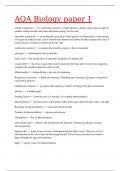Exam (elaborations)
Philosophy of Religion Exam VERIFIED QUESTIONS AND ANSWERS
- Course
- Institution
definition of religion>>> commonly divided into 2 types: substantive and functional *often, religions combine the two approaches substantive religion>>> attends to its substance, nature, essence; focus on the CONTENT or religious belief in God or the supernatural Problem with...
[Show more]



